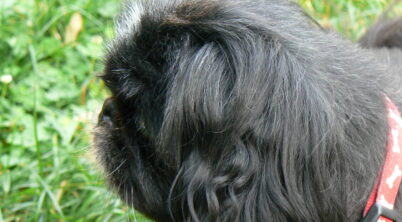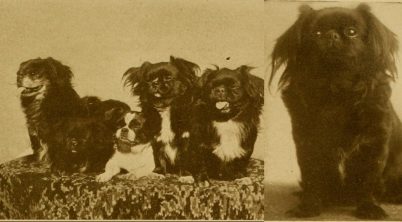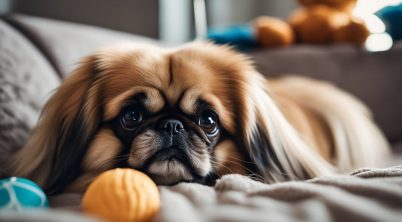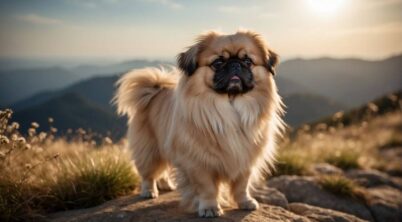Table of Contents
What New Owners Should Know
The Pekingese, a toy dog breed with deep roots in the history of ancient China, is often considered by prospective pet owners looking for a distinguished and companionable first dog. Originating from the lap of Chinese Imperial luxury, the breed was once ensconced within the walls of the Forbidden City, the privilege of owning one reserved solely for royalty. With its regal heritage, the Pekingese is a true symbol of canine aristocracy—reflective in both their confident demeanor and their longstanding association with Chinese emperors and nobles.
This breed’s characteristic lion-like mane contributes both to its unique aesthetics and to the air of nobility that seems to surround it. Despite their small stature, Pekingese possess a bold and courageous spirit, a testament to their storied past where they were revered and protected. They are known for their independent nature, yet they build strong, devoted bonds with their owners, exhibiting a balance of loyalty and self-reliance which can make them suitable to become a beloved first dog.
While their luxurious coat and historical significance may be enticing, it’s important for would-be owners to understand the responsibilities associated with the breed. The Pekingese requires a fair amount of grooming to maintain its distinctive appearance and also calls for a patient, gentle training approach to adapt well to their human family’s lifestyle. With a clear and knowledgeable preparation for the breed’s needs, owners of Pekingese can look forward to a fulfilling companionship that honors the legacy of this imperial breed.
Physical Characteristics
The Pekingese is often referred to as a “lion dog” due to its confident and regal disposition matched by its distinctive appearance. The breed possesses a notably flat face, known scientifically as brachycephalic syndrome, resulting in a short snout that is a defining feature of its large, short-muzzled head. This is accompanied by large, expressive eyes that are characteristic of the breed.
In terms of size, the Pekingese is classified as a small dog, fitting comfortably within the toy group. It typically weighs between 6 and 14 pounds. Height-wise, they stand about 6 to 9 inches at the shoulder, embodying a compact stature.
Coat and Colors:
- Texture: A double coat that is long and coarse
- Grooming: Requires regular maintenance to prevent matting
- Colors: Comes in a variety of colors including black, red, fawn, white, gold, blue, gray, cream, and sable
The coat not only contributes to the animal’s lion-like appearance but also requires significant grooming to maintain its condition and aesthetic. Regular brushing is an integral part of Pekingese care, as it helps manage shedding and prevents tangles.
Pekingese have a unique “rolling gait,” which, added to their physical traits, makes their movement distinct. When it comes to exercise, they typically require less physical activity compared to larger breeds but still benefit from regular, light exercise to stay fit and healthy. The breed’s physical characteristics require owners to be mindful of their health, as the flat face can contribute to breathing issues, and their long coat needs consistent grooming.
Temperament and Behavior
The Pekingese dog breed possesses a distinct temperament combining regal sophistication with steadfast loyalty. Understanding their inherent personality traits, social and training requirements, and suitability as family pets is essential for potential owners.
Personality Traits
The Pekingese is known for its dignified demeanor and independent nature. These dogs often exhibit self-importance, a trait harking back to their history as companions in Chinese imperial courts. Despite their small stature, they carry themselves confidently and can be surprisingly bold and alert to their surroundings. The breed’s hallmark loyal and affectionate behavior makes them adoring companions, although they may display stubbornness in their actions.
Social and Training Needs
Pekingese can be difficult to train due to their independent spirit. However, they respond well to positive reinforcement and consistent training methods. Socialization is crucial from a young age to foster friendly interactions with people and other animals. They are not the most playful breed but do enjoy occasional play sessions, and lack of proper socialization may lead to a reserved or cautious temperament around strangers.
Suitability as Family Pets
As family pets, Pekingese are affectionate lapdogs that thrive on human companionship. Their energy level is subdued; they often prefer lounging to playing. However, they do possess a streak of playfulness that emerges with engaging toys and games. Known for their loyal and affectionate nature, they can form strong bonds and often select a favorite family member. The breed is well-suited to a tranquil home environment where they can assume a regal, sophisticated presence. They may not be the best choice for families with very young children due to their need for gentle handling and respect for their autonomy.
Health and Care
Pekingese dogs are known for their long, lavish coats and lion-like mane, requiring regular grooming to keep their fur mat-free. Owners should brush their Pekingese several times a week to prevent tangles and reduce shedding. Beyond their unique coats, Pekingese may have a lifespan of 12 to 14 years. However, these dogs have specific health challenges that must be managed responsibly.
They’re prone to certain health issues like heart murmur, eye issues, including keratoconjunctivitis sicca (dry eye) and progressive retinal atrophy, which can lead to vision problems or blindness. Awareness and regular veterinary check-ups can help in early detection and management of these conditions.
Regarding their exercise needs, Pekingese dogs possess a moderate energy level. While exercise is crucial for their well-being, they typically require less intense activity compared to larger breeds. Short daily walks and play sessions are sufficient to meet their physical requirements; however, vigorous activities should be limited due to their susceptibility to heat stress and respiratory problems.
In terms of maintenance, owners should consider a diet that supports optimal health, regular vaccinations, and preventative care. Pekingese are a brachycephalic breed, meaning they have short noses, which can lead to respiratory complications. A cool, air-conditioned environment is beneficial for them, especially during hot weather.
It is essential for Pekingese owners to maintain a vigilant care routine to ensure their dogs lead a healthy and happy life.
| Health Aspect | Considerations for Pekingese |
|---|---|
| Lifespan | 12-14 years |
| Common Health Problems | Heart murmur, Eye issues, Respiratory difficulties |
| Grooming | Frequent brushing required |
| Exercise Needs | Daily walks and play, avoid heat and intensive activities |
| Maintenance | Balanced diet, regular vet check-ups, cool living conditions |
Choosing a Pekingese
When considering a Pekingese as a first dog, prospective owners should carefully evaluate their lifestyle fit, the small size and unique needs of the breed, and the commitment to its lifespan. This section will guide through the important steps of acquiring a Pekingese and preparing for its arrival.
Purchasing or Adopting
A prospective owner can either purchase a Pekingese puppy from a reputable breeder or adopt from a shelter or rescue. Toy breeds like the Pekingese require responsible breeders who ensure the health and socialization of the puppies. Alternatively, adopting an adult Pekingese can provide insight into their temperament and may support the ethical choice of saving a life.
- Reputable Breeders: Look for breeders with positive reviews, health guarantees for puppies, and extensive knowledge about the Pekingese breed.
- Adoption: Check local shelters and specialized Pekingese rescue groups, where adult dogs may be available and longing for a home.
Preparing Your Home
Pekingese adapt well to apartment living due to their small size, but they have a long lifespan and specific needs. They require a comfortable, safe environment, and, as lapdogs, they appreciate a cozy spot for resting.
- Safety:
- Remove hazards like small objects that can be ingested.
- Secure windows and balconies.
- Comfort:
- Provide a soft bed in a quiet space.
- Ensure access to clean water and age-appropriate food.
Integrating into the Family
Integrating a Pekingese into the family is a process that requires patience and understanding of their social and watchful nature. They are typically friendly and may exhibit watchdog behaviors.
- Establish a routine with consistent feeding, walking, and playtime.
- Gradually introduce them to family members and other pets to foster social integration.
- Provide positive reinforcements to encourage good behavior and strengthen the bond.
It is crucial for potential Pekingese owners to be aware of the breed’s particular needs, such as grooming requirements, to ensure a healthy and happy life for their new companion.








